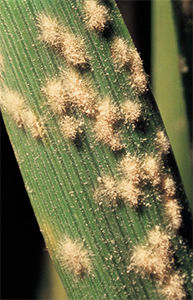Powdery Mildew in Cereal Crops
January 31, 2022

Powdery mildew, caused by the fungus Blumeria graminis, is one of the most common and damaging foliar diseases in wheat. Powdery mildew exists almost everywhere wheat is grown. As an obligate parasite, the fungus grows only on living tissue.
Powdery mildew is particularly a problem in regions with high nitrogen fertilization and high stand densities. Cool, moist weather conditions with high relative humidity – 97 to 100 percent – enhance germination of the fungal infection. Optimum temperatures for development of powdery mildew are 59 to 70 degrees F, typically making it the first leaf disease of the season. When temperatures climb above 77 degrees F, powdery mildew begins to deteriorate. In much of the Midwest growing regions, powdery mildew in wheat occurs from April to July, but it can infect newly emerged wheat in the fall.
Identification and Lifecycle
Symptoms of powdery mildew are white, cottony patches (colonies of mycelium) and asexual spores (conidia) on the surface of the wheat plant. These patches of white mold are typically seen in early to mid-April through July in most of the Midwest. Although the white patches can occur on all aerial parts of the plant, including stems and heads, they are most easily visible on the upper surfaces of lower leaves.
Later, the white colonies or patches turn dull gray to gray-brown in color. Severe infections can result in wheat plant stunting. Heads on the later tillers may show more heavy infection because they reside lower in the wheat canopy, where humidity remains high. The leaf tissue on the opposite side of the white mold growth turns yellow and then changes to tan or brown.
As plants mature in June, small, distinct black dots containing spores develop on plant leaves. In this phase of the disease, spores reside in older, gray-colored powdery mildew colonies that infect the wheat field.
Crop Damage
The greatest yield loss occurs when the flag leaf of a wheat plant becomes severely diseased by powdery mildew by the time of heading. Damage caused by the powdery mildew fungus increases the number of non-productive tillers, resulting in yield loss even at low levels of infection.
Disease infection robs yield by reducing kernel size, number of seeds per unit area and test weight. A rule of thumb is the earlier a spring mildew infection begins and the higher up the plant it spreads by flowering, the greater the resulting yield loss. According to research by The Ohio State University Extension, wheat yield losses from powdery mildew may be as high as 45 percent.
Fungicides
Excellent powdery mildew control can be achieved with commercially available fungicides. The decision to use fungicides should be based on scouting for symptoms. It’s important to assess disease severity from the growth stages of tiller elongation through flowering. Experts recommend application timing to keep the upper leaves of the wheat plant disease-free, allowing full potential for grain fill. Other factors affecting fungicide application are infection levels in the field, the susceptibility of the variety and the market price for wheat grain.
Prosaro® PRO 400 SC fungicide provides preventive and curative action against key cereal leaf diseases such as various types of rust, Septoria leaf blotch, tan spot and powdery mildew. Additionally, Prosaro PRO provides unsurpassed activity against head diseases such as scab (Fusarium head blight) and glume blotch. It’s a good choice to ensure grain quality and enhance yield potential, maximizing ROI.
For more information on wheat disease control options from Bayer, please contact your local Bayer Cereal Expert or visit CerealExperts.com.
ALWAYS READ AND FOLLOW PESTICIDE LABEL DIRECTIONS. Not all products are registered for use in all states and may be subject to use restrictions. The distribution, sale, or use of an unregistered pesticide is a violation of federal and/or state law and is strictly prohibited. Check with your local dealer or representative for the product registration status in your state. Bayer and Prosaro® are registered trademarks of Bayer Group. For additional product information call toll-free 1-866-99-BAYER (1-866-992-2937) or visit our website at www.BayerCropScience.us. Bayer CropScience LP, 800 North Lindbergh Boulevard, St. Louis, MO 63167. ©2023 Bayer Group. All rights reserved.